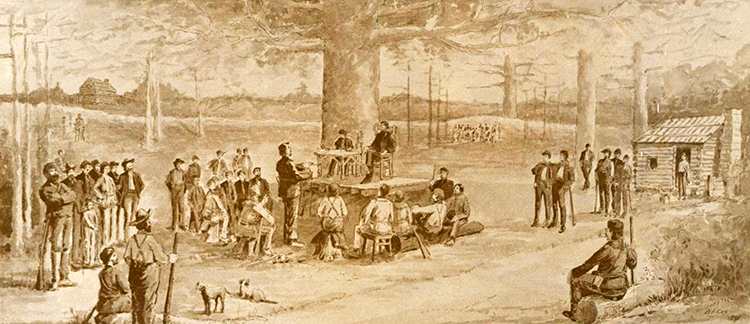Henderson, Pleasant
9 Jan. 1756–November 1840
Pleasant Henderson, pioneer, soldier, and merchant, was born in Granville County, possibly the youngest son of Samuel and Elizabeth Williams Henderson. In his late teens he became associated with his elder brother Richard, who had formed the Transylvania Company, in the opening of Kentucky to settlement. In 1775 he joined Daniel Boone and his party in cutting the Wilderness Road; he was described as a "fellow pioneer with Boone at Booneborough," the fort-settlement on the Kentucky River. Here on 23 May 1775 the first elected government of Transylvania met under the leadership of Richard Henderson. Nevertheless, the proposed fourteenth American colony failed to gain recognition by the Second Continental Congress chiefly because of the opposition of the Virginia delegation.
Pleasant Henderson returned to his parents' home in Granville and early in 1776 volunteered for duty in a county militia unit, which was sent to Cross Creek to meet the Highland Tory units gathered in support of the Crown. Henderson's unit arrived after the Battle of Moore's Creek Bridge and participated only in the rounding up of Tory supporters in the area. After several months' service, the unit was released. In late 1778 Henderson again volunteered for a militia company being formed at Charlotte to aid the states of South Carolina and Georgia, threatened by a new British invasion. He served as a lieutenant until April or May 1779 but was not involved in any major battle. During this campaign he briefly met his older brother William, who was a resident of South Carolina. Later in the war William became a general.
In 1779, North Carolina and Virginia agreed to extend the dividing line between their respective states and Richard Henderson was chosen a North Carolina commissioner. In November and December of that year, when the line was extended to the Tennessee River, Judge Henderson and his brothers Pleasant, Nathaniel, and Samuel were parties to the survey. The Henderson brothers continued on to Boonesborough and during the first half of 1780 were involved in efforts to form a government for Kentucky, bringing together the various Cumberland settlements and the remainder of the Transylvania Company. The result was the famous Cumberland Compact, prepared chiefly by Richard Henderson.
In 1781, following the Battle of Cowpens and the invasion of North Carolina by Cornwallis, Pleasant Henderson was called into service for the last time. Appointed major under the command of Colonel Malmedy, a Frenchman, he and his regiment joined General Nathanael Greene's army at Troublesome Iron Works two days after the Battle of Guilford Court House. They were later involved in a skirmish at Ramsey's Mill.
As clerk of the Council of State from 1782 to 1784, Henderson served as the private secretary of Governor Alexander Martin. The governor's sister, Anne Jane Martin, had married Henderson's brother, Thomas, in 1778 and from that time the two families were very close. In 1783 Pleasant was assigned a grant of 640 acres, which came to be known as Mt. Pleasant, adjoining Alexander Martin's Danbury estate.
When Judge Richard Henderson died in 1785, Pleasant acted as the executor of his estate. In January of the following year he married, in Surry (now Stokes) County, Sarah Martin, the daughter of Colonel James and Ruth Rogers Martin and a niece of Governor Alexander Martin. It appears that the couple resided primarily in Granville County until at least 1790, when they were listed in the census as living in Henderson District of that county. Soon afterwards they took up residence at Mt. Pleasant in Rockingham County.
In 1797 Henderson moved from Mt. Pleasant to Chapel Hill, where on 9 December he was chosen steward of The University of North Carolina. He built a large home on Franklin Street for his growing family and student boarders. In 1802 he gave up the job of steward and, though elected a trustee of the university, declined the office. At this time he opened a store called Henderson and Searcy. In 1807 he was elected clerk of the House of Commons, succeeding John Hunt who had held the office since 1778. Henderson served until 1830, continuing his residence in Chapel Hill. In 1816 he sold his Mt. Pleasant home to his nephew, Alexander Henderson of New Bern.
On 21 May 1830 the Hendersons left Chapel Hill and on 7 July arrived in Carroll County, Tenn., where they established a new home. They were the parents of seven children: James Martin, William, Tippoo Saib, Mark Mitchell, Eliza Jane (Mrs. Hamilton C. Jones), Pleasant, and Alexander Martin. Henderson died in Tennessee.
References:
John L. Cheney, Jr., ed., North Carolina Government, 1585–1974 (1975).
Early Families of the North Carolina Counties of Rockingham and Stokes with Revolutionary Service (1977).
Archibald Henderson, The Campus of the First State University (1949) and "Richard Henderson: The Authorship of the Cumberland Compact and the Founding of Nashville," North Carolina Booklet, vol. 21, July-October 1921, January-April 1922.
Pension Application: 12 Sept. 1832—Pleasant Henderson S1912 (National Archives, Washington, D.C.).
Worth S. Ray, ed., Colonial Granville and Its People (1973 reprint).
Rockingham County Deeds.
U.S. Census of 1790.
John H. Wheeler, Reminiscences and Memoirs of North Carolina and Eminent North Carolinians (1966 reprint).
Additional Resources:
"Pension application of Pleasant Henderson S1912." Southern Campaign Revolutionary War Pension Statements & Rosters. http://revwarapps.org/s1912.pdf (accessed January 7, 2013).
"Letter from Pleasant Henderson to Walter Alves, July 14, 1799." The First Century of the First State University. Documenting the American South, University of North Carolina at Chapel Hill. https://docsouth.unc.edu/unc/unc06-125/unc06-125.html (accessed January 7, 2013).
Horton, Lucy Henderson, compiler. "Archibald Henderson (1768-1822)." Family History Compiled by Lucy Henderson Horton. Franklin, Tenn.: Press of the News. 1922. 211-212. http://books.google.com/books?id=hWtVAAAAMAAJ&pg=PA211#v=onepage&q&f=false (accessed January 7, 2013).
Image Credits:
Cox, B.F. "Photograph, Accession #: H.1946.14.62." 1900-1920. North Carolina Museum of History.
1 January 1988 | Rodenbough, Charles D.
